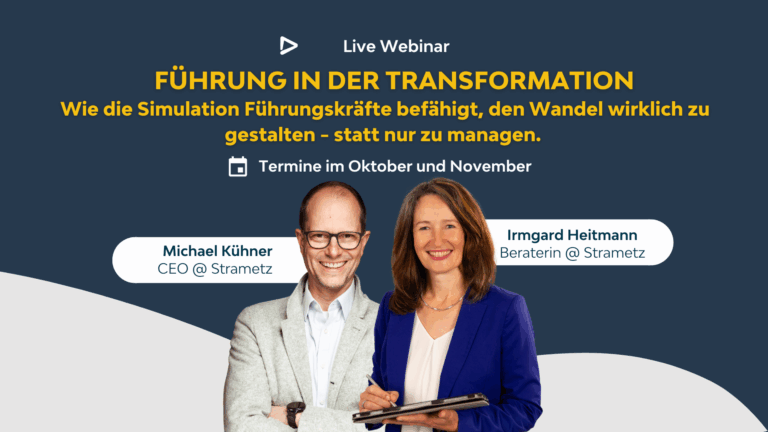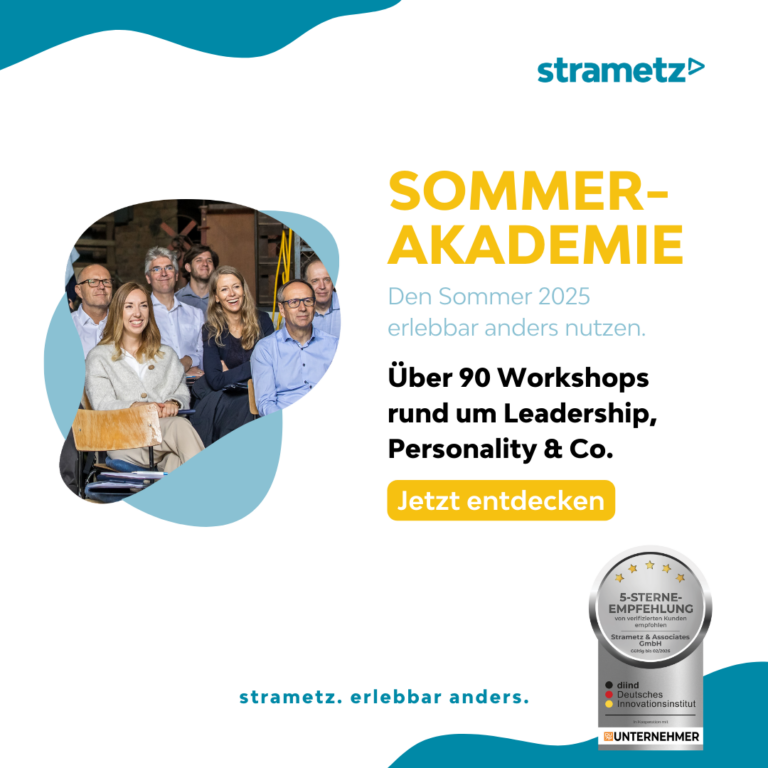How to increase the validity of your assessment center in the design phase
1st success factor: Careful requirements analysis
The first step in designing a good quality assessment center is to analyze the requirements associated with the professional activity. Many companies are content to list abstract competency terms, but these are often very general and apply to many positions in the company (e.g., communication skills). In contrast, it is important to work out the specific requirements of a particular job in the respective corporate culture. To arrive at these requirements, interviews or 360-degree assessments of individuals can be used to illuminate the vacant position from different perspectives. The Critical Incident Technique method is particularly suitable for this purpose.
2. success factor: differentiation between potential and competence for the orientation of the assessment center
Should one or more candidates be selected for a specific target position/level or are potential candidates (trainees, talents, management trainees) generally needed for later key positions in the company?
On the basis of this fundamental objective, it must be determined whether competencies or potentials should be assessed. Competencies are already retrievable behaviors that can be used immediately. Potentials are characteristics of a person that can lead to needed competencies. Today, companies talk a lot about potentials, but mostly competencies are expected. Real potentials that are still developable may not be recognized.
If the focus is on a person’s potential, an assessment center alone is usually not enough. Here, further diagnostic additions are needed that include talent and personality traits in more detail. For this reason, we at Strametz & Associates have developed a model that allows a correct delineation of potential and competence and supports the precise selection of measurement instruments in the context of an assessment center.
3rd success factor: assessment scales with behavioral anchors
Observation and evaluation in the assessment center must not be based solely on gut feeling, but requires sound judgment. This is based on rating scales that set the standard of when a behavior can be considered good (purposeful) or not good (not appropriate in the situation). For this purpose, so-called behavioral anchors literally describe the ability and skill factors to be relevant and provide a fixed point of orientation for the assessment. Diagnostics, which is done on the basis of pure observation, provides many hypotheses about the general behavior of people. However, the less knowledge an observer has about the background of a demonstrated behavior, the more important it is to use concrete behavioral anchors. The mere observation, for example, that a person behaves in a restrained manner has no significance for the future behavior of this person, if the observer cannot understand and interpret the background of a restraint.
What you need to consider before conducting an assessment center
4. success factor: use of the critical incident technique
The Critical Incident Technique(CIT) is based on the basic idea of classifying certain behaviors (or critical incidents) as particularly successful or unsuccessful with respect to a specific goal. The technique can already be used in the requirements analysis (see success factor no. 1) or in the exercises of an assessment center. Both in the context of an interview and in role plays or dynamic exercises, such critical situations are created (or presented in the interview) that show those behaviors and factors that are crucial for mastering the work task.
With this method, concrete actions and processes can be collected very well, as well as actually effective (positive and negative) factors (causes, contextual conditions, effects) in very concrete, real situations. It is important to select such factors that are critical to the success of an event.
The application of CIT in the interview starts at critical events and asks the person concerned around these events. It is important for the survey to identify actual critical events. The art of interviewing is to allow the interviewee to immerse him/herself in the situation and then to ask concrete action-related questions and to collect as many important parameters as possible.
Strametz [&] Associates successfully uses CIT primarily in the context of simulation exercises, which makes behavior observable in concrete, social and dynamic situations and allows evaluation in terms of positive or negative influence on the social system.
5. success factor: observer training and observer composition
Studies show that observer training increases the validity of the procedure. Every observer should know the difference between evaluating and observing before going into evaluation. In addition, the typical distortions of human
To make people aware of judgment (stereotypes, similarity, attribution, attractiveness, etc.). In addition to practical exercises on observation and evaluation traps and patterns, the rules of the game, the procedure, the exercises, the evaluation scales and their handling are to be trained.
The highest predictive accuracy of an assessment center usually comes from the mix of managers and psychologists on the observer team. It is therefore important and advisable to assemble heterogeneous teams of observers in such a way that synergies are created. The combination of leadership experience and thorough psychological-diagnostic understanding is a useful combination here.
6. success factor: focus in structuring and conducting the assessment center
The duration of assessment centers has decreased in recent years, often with a corresponding decrease in quality. Because the temptation is great to perform the same number of exercises in less time. It is important to remain true to the two basic principles of the assessment center, namely first: to measure each competence dimension with at least two independent exercises and second: not to observe too many competence dimensions in one exercise. Experts here give different recommendations as to the maximum number per exercise. In our experience, it also depends on the length and complexity of the exercises. Normally, three to a maximum of five competencies per exercise are useful; in longer simulation exercises, more competencies may be observed, although it is possible that a competency may not be observable if the dynamics of the situation do not allow it. Diagnostically, it makes sense to measure rather few but significant[nbsp] competence dimensions well, instead of touching on many competences in a quick pass.
Further recommendations for structuring and implementation:
- Use of a multi-method matrix that relates competency dimensions and procedures.
- When possible, use consultants or trained role players rather than other applicants during role interviews
- Avoid targeted covert observations of applicants during breaks
- Moderated observer conference
- Define clear decision criteria for hiring, selection, or rejection.
Whereas in the past the rule was not to allow personal contact between observers and applicants, today this is less and less feasible due to the “employer image” factor. Assessment centers are experiences that an applicant will not soon forget. And a positive, appreciative interactive atmosphere naturally has a more positive effect here than a professional but cool atmosphere. Therefore, we no longer see this topic so dogmatically, because the observers, who are often experienced managers of the company, are not only observers but also decision-makers in the day-to-day business of the company and also make decisions there mostly based on a holistic assessment.
Higher efficiency in the implementation of assessment centers
7. success factor: realistic exercises
Tasks such as “Dance your name for us” may seem amusing, but they hardly have any significance for how successful someone will be in the future, and they also significantly reduce the participant’s acceptance. More abstract exercises such as “bridge building” or “space travel” are also discouraged. By using the CIT [nbsp](see success factor 4) [nbsp], success-critical events from the everyday life of the position or target level to be filled are determined, which can be well represented in simulation exercises. A special reality-based challenge is created when these events are not only depicted in 1:1 role conversations, but in more complex, social, and at the same time dynamic situations that exhibit a complexity of personal, task-related, and situational variables. This makes observation more challenging, but here, in our experience, you see real intuitive behavior, which participants also cannot prepare for beforehand.
As a specialist in leadership simulation, Strametz has built up a large repertoire and experience of simulation elements over many years in order to cover a wide range of critical incidents and adapt them for new requirements at any time.
8. success factor: combination with standardized test procedures
Performance or personality tests are a good complement to the assessment center. Practically, this sometimes well reduce the waiting time between individual exercises. Such tests also provide an opportunity to examine relevant competencies in a different way, allowing for a good comparison to behavior-based exercises. Tests are indispensable, especially for measuring potential, because certain characteristics of potential, such as intelligence, innate motive patterns as well as personality traits, are difficult to determine by purely observing behavior. In addition, certain professional or methodical achievements can only be measured in a clean and comparative manner using standardized and scientifically validated procedures.
Fortunately, the acceptance of tests and psychometric procedures has also increased thanks to globalization, because in the USA and other countries (including Europe) tests and psychometric procedures are much more widespread than in Germany and are often[nbsp] a standard in personnel diagnostics.
9. success factor: check integration of feedback and reflection
Depending on the objective of the assessment center, the integration of interim or final feedback and reflection elements must be decided. Particularly in the case of selecting high potentials for later key positions (apprentices, trainees, talents, management trainees), basic attitudes, attitudes, understanding of roles and the ability to reflect play an important role. Let’s remember success factor #2: Potential is the prerequisite but not the guarantee for achieving the competencies required later. Most important is the ability to reflect, without which further learning processes are much more laborious. Attitude and mindset are also important, especially against the backdrop of a fit with the corporate culture. In the context of debriefings of a simulated situation, short feedback or reflection elements (e.g. after watching the video recording of an exercise), these potential factors can be collected. Of course, this already describes a fluid boundary to a typical development center, but our practice shows that especially in the area of talent pool selection, the interface to HR development is regularly given.
What should not be missing at the end of an assessment center
10. success factor: fairness and acceptance of the assessment center
In times of dwindling human resources, appreciation and personnel marketing aspects are becoming increasingly important. For example, handing out test results and/or short recommendations for personal development can leave a positive impression even on rejected applicants, which can contribute to an equally positive opinion of the company.
Of course, this is particularly important in the case of internal staffing. Placing an internal rejection is very risky in terms of further motivation. Good organization, communication and detailed feedback are therefore necessary.
For hired applicants, a comprehensive assessment with development recommendations directly supports the further onboarding, induction and development process.
The most important for your assessment center in a nutshell
Performance or personality tests are a good complement to the assessment center. Practically, this sometimes well reduce the waiting time between individual exercises. Such tests also provide an opportunity to examine relevant competencies in a different way, allowing for a good comparison to behavior-based exercises. Tests are indispensable, especially for measuring potential, because certain characteristics of potential, such as intelligence, innate motive patterns as well as personality traits, are difficult to determine by purely observing behavior. In addition, certain professional or methodical achievements can only be measured in a clean and comparative manner using standardized and scientifically validated procedures.
Fortunately, the acceptance of tests and psychometric procedures has also increased thanks to globalization. In the USA and other countries (including Europe), tests and psychometric procedures are much more widespread than in Germany and are often a standard in personnel diagnostics.










